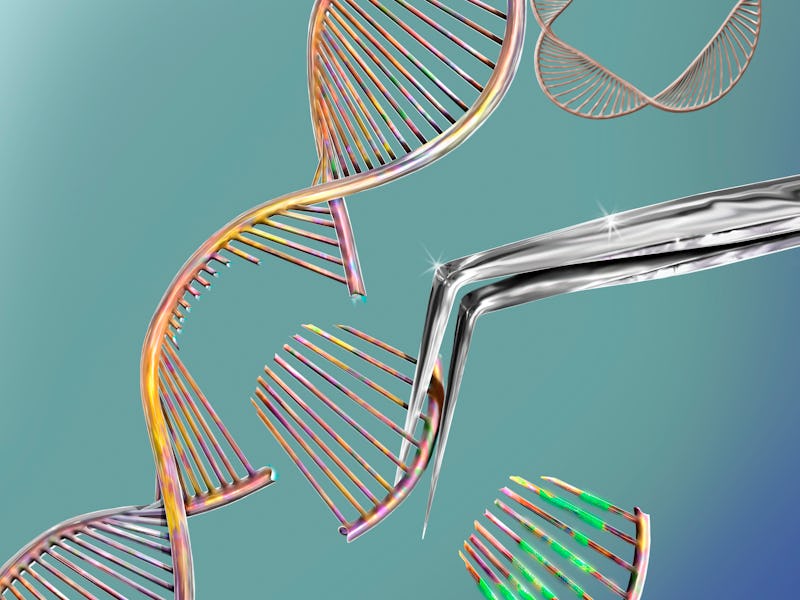Scientists just bypassed millions of years’ worth of evolution in mice
But they don’t have mutant-making in mind.

The buzzy field of synthetic biology aims to create complex life from customized DNA, a goal that has been decades in the making.
Now, researchers have taken a major step toward that sci-fi ambition: For the first time ever, a team has successfully mixed and matched mammal chromosomes, large-scale changes that would ordinarily take millions of years to achieve naturally via evolution. Such research might shed light on diseases stemming from chromosomal abnormalities in people, according to a new study published in Science.
This may look like a normal mouse, but its chromosomes were modified by Li-Bin Wang and colleagues in a groundbreaking experiment.
HERE'S THE BACKGROUND — Genetic mutations normally help rearrange chromosomes over millions of years. For example, the human genome is normally divided into 23 pairs of chromosomes, with each parent supplying a set of 23 chromosomes. But the gorilla genome consists of 24 pairs. That’s because two sets of chromosomes fused in human ancestors, while they remained separate in gorilla ancestors.
Rearrangements of chromosomes usually happen roughly every 1.6 per million years in primates and every 3.2 to 3.5 per million years in rodents. But synthetic biologists are exploring ways to engineer these changes on a far shorter timeline — certainly within a human lifetime.
"An ultimate goal of synthetic biology is to generate complex multicellular life with designed DNA sequences," says study co-author Li-Bin Wang, a cell biologist at the Beijing Institute for Stem Cell and Regenerative Medicine.
To create such organisms, she explains, it’s necessary to carry out the sort of large-scale manipulation proven possible in this experiment.
Previously, researchers succeeded in engineering chromosomes in yeast, a fungus that makes our beloved sourdough and beer possible. But until now, no one had accomplished it with mammals.
The problem was that molecules are normally bound to DNA that help control which genes are active or inactive, a phenomenon known as genomic imprinting. Past chromosome-modifying experiments in mammal cells often disrupted the patterns of this genomic imprinting in mammal cells, which in turn prevented growing live animals from these cells.
Over the past few decades, scientists have blasted cells with chemicals or radiation to cause massive shifts in chromosomes. But now, synthetic biologists want to make these changes with a more precise, repeatable method.
The green and red chromosomes in this image were fused together in the lab.
What they did — In the new study, researchers in China worked with mice, which normally have 20 pairs of chromosomes. They performed the experiment on embryonic stem cells from unfertilized mouse embryos, each of which only contained one set of chromosomes.
The scientists found that getting rid of three imprinted regions can kick off genomic imprinting in embryonic stem cells. As a result, they could fuse chromosomes in these cells and allow them to grow into embryos.
In some stem cells, the researchers fused two medium-sized chromosomes — the tail of number 4 to the head of number 5, leading to cells dubbed “4+5.” In others, they fused the two largest chromosomes, numbered 1 and 2. They did this by either sticking the tail of chromosome 1 to the head of chromosome 2 (for cells dubbed “1+2”) or fusing the tail of chromosome 2 with the head of chromosome 1 (cells that were called “2+1”).
The scientists then injected these altered embryonic stem cells into mouse egg cells, where they could develop into embryos in surrogate mouse mothers. These each had only 19 pairs of chromosomes, one pair fewer than natural mice. While mouse pregnancy lasts around three weeks, the genetic tweaking only took a few days — magnitudes quicker than actual evolution.
The technique used by Wang’s team won’t be used to create mutants, it seems.
What they found — The scientists observed that the 2+1 cells acted abnormally, so the embryos died only about 12 days into development. Compared to both typical mice and the 4+5 mice, the 1+2 cells developed into pups that grew into larger, more anxious, and slower-moving adults.
Only the 4+5 mice were able to produce offspring with standard mice, but at a much lower rate than typical lab mice. Still, they were able to pass on their fused chromosome to their rodent babies. This win has major ramifications for future research.
"Our chromosome fusion technology adds to the toolbox of synthetic biology," Wang says.
What’s next — Moving forward, Wang’s team may create mice with chromosome fusions to better understand diseases associated with chromosome abnormalities, such as infertility and childhood leukemia, Wang says.
You may be wondering: Can researchers use this technique to forge new species? Unfortunately for sci-fans, Wang says it’s intended to study how chromosomes evolve in nature, rather than creating some sort of mutant creature.